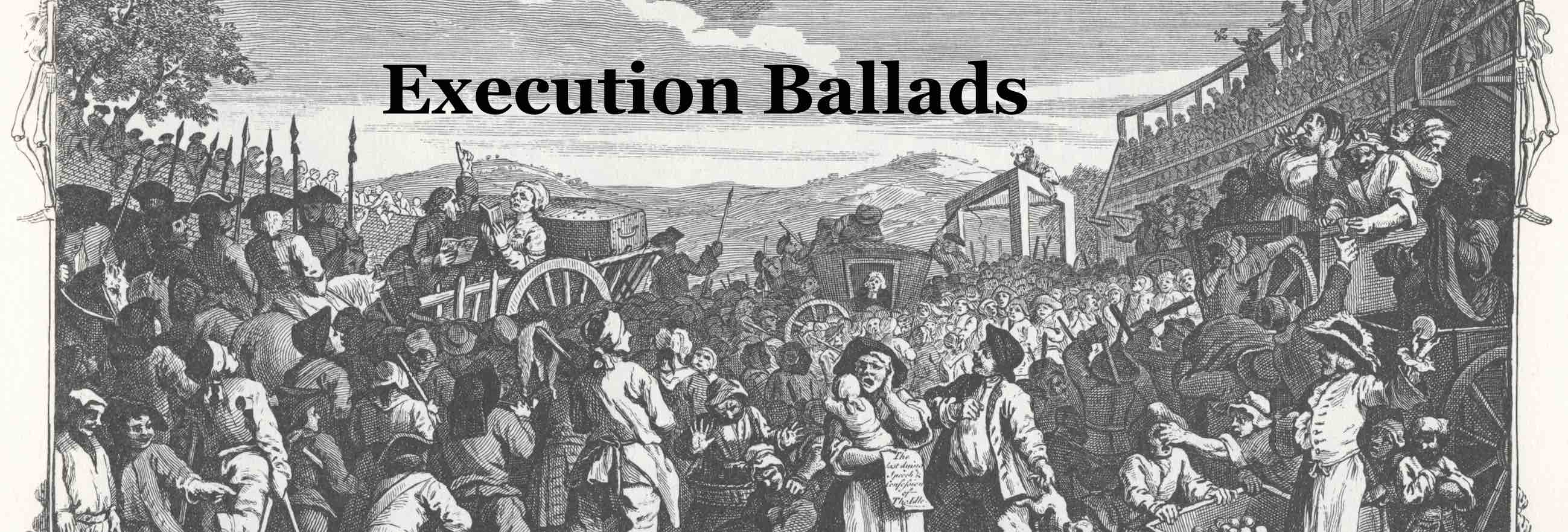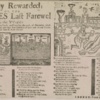Villany Rewarded;
Title
Villany Rewarded;
Subtitle
OR, THE PIRATES Last Farewel To the VVorld: Who was Executed at Execution Dock, on Wednesday the 25th. of November, 1696. Being of Every's Crew. Together with their free Confession of their most Horrid Crimes.
Digital Object
Image / Audio Credit
Magdalene College - Pepys Library, Pepys Ballads 2.199; EBBA 20813
Set to tune of...
Transcription
WEll may the World against us cry,
for these our Deeds most base,
For which, alas! we now must dye, Death looks us in the face;
Which is no more than what's our due, since we so wicked were,
As here shall be declar'd to you, let Pyrates then take care.
We with our Comrades, not yet ta'en, together did agree,
And stole a Ship out from the Groyne, to Roam upon the Sea:
With which we Robb'd, and Plunder'd too, no Ship that we did spare,
Thus many a one we did undo,
let Pyrates then take care.
Our Ship being well stored then for this our Enterprise,
One Hundred and Eighty Men there was in her likewise:
We Pillag'd all we could come nigh, no Nation did we spare,
For which a shameful death we dye, let Pirates then take care.
We Robb'd a Ship upon the Seas, the Gunsway call'd by name,
Which we met near the East-Indias, and Rifled the same;
In it was Gold and Silver store, of which all had a share,
Each man 600 pounds and more let Pirates then take care.
Thus for some time we liv'd, and Reign'd as masters of the Sea,
Every Merchant we detain'd and us'd most cruelly,
The Treasures took, we sunk the Ship, with those that in it were,
That would not unto us submit,
let Pirates then take care.
Thus Wickedly we e'ery day liv'd upon others good,
The which, alas! we must repay now with our dearest blood,
For we on no one mercy took, nor any did we spare,
How can we then for mercy look, let Pirates then take care.
We thus did live most cruelly, and of no danger thought,
But we at last, as you may see, are unto Justice brought,
For Outrages of Villany, of which we Guilty are,
And now this very day must dye, let Pirates then take care.
Now farewel to this wicked World, and our Companions too,
From hence we quickly shall be hurl'd to clear the way for you,
For certainly if e're you come to Justice as we are,
Deserved death will be your doom, then Pirates all take care.
for these our Deeds most base,
For which, alas! we now must dye, Death looks us in the face;
Which is no more than what's our due, since we so wicked were,
As here shall be declar'd to you, let Pyrates then take care.
We with our Comrades, not yet ta'en, together did agree,
And stole a Ship out from the Groyne, to Roam upon the Sea:
With which we Robb'd, and Plunder'd too, no Ship that we did spare,
Thus many a one we did undo,
let Pyrates then take care.
Our Ship being well stored then for this our Enterprise,
One Hundred and Eighty Men there was in her likewise:
We Pillag'd all we could come nigh, no Nation did we spare,
For which a shameful death we dye, let Pirates then take care.
We Robb'd a Ship upon the Seas, the Gunsway call'd by name,
Which we met near the East-Indias, and Rifled the same;
In it was Gold and Silver store, of which all had a share,
Each man 600 pounds and more let Pirates then take care.
Thus for some time we liv'd, and Reign'd as masters of the Sea,
Every Merchant we detain'd and us'd most cruelly,
The Treasures took, we sunk the Ship, with those that in it were,
That would not unto us submit,
let Pirates then take care.
Thus Wickedly we e'ery day liv'd upon others good,
The which, alas! we must repay now with our dearest blood,
For we on no one mercy took, nor any did we spare,
How can we then for mercy look, let Pirates then take care.
We thus did live most cruelly, and of no danger thought,
But we at last, as you may see, are unto Justice brought,
For Outrages of Villany, of which we Guilty are,
And now this very day must dye, let Pirates then take care.
Now farewel to this wicked World, and our Companions too,
From hence we quickly shall be hurl'd to clear the way for you,
For certainly if e're you come to Justice as we are,
Deserved death will be your doom, then Pirates all take care.
Method of Punishment
hanging
Crime(s)
piracy
Date
Execution Location
Execution Dock
Printing Location
LONDON: Printed for Charles Barnet, 1696.
Notes
Wikipedia: Execution Dock was used for more than 400 years in London to execute pirates, smugglers and mutineers that had been sentenced to death by Admiralty courts. The "dock", which consisted of a scaffold for hanging, was located near the shoreline of the River Thames at Wapping. Its last executions were in 1830.The legal jurisdiction for the British Admiralty was for all crimes committed at sea. The dock symbolised that jurisdiction by being located just beyond the low-tide mark in the river. Anybody who had committed crimes on the seas, either in home waters of abroad, would eventually be brought back to London and tried by the High Court of the Admiralty.
Capital punishment was reserved for acts of mutiny that resulted in death and for murders on the High Seas. Those sentenced to death were usually brought to Execution Dock from Marshalsea Prison (although some were also transported from the Newgate). The condemned were paraded across London Bridge past the Tower of London. The procession was led by the High Court Marshal on horseback (or his deputy). He carried a silver oar that represented the authority of the Admiralty. Prisoners were transported in a cart to Wapping, with them was a chaplain who encouraged them to confess their sins. Just like the execution procession to Tyburn, condemned prisoners were allowed to a drink a quart of ale at a public house on the way to the gallows. An execution at the dock usually meant that crowds lined the river's banks or chartered boats moored in the Thames to get a better view of the hangings. Executions were conducted by the hangmen who worked at either Tyburn and Newgate Prison.
With a particular cruelty reserved for those convicted of acts of piracy, hanging was done with a shortened rope. This meant a slow death from strangulation on the scaffold as the drop was insufficient to break the prisoner's neck. It was called the Marshal's dance because their limbs would often be seen to 'dance' from slow asphyxiation. Unlike hangings on land such as at Tyburn, the bodies of pirates at Execution Dock were not immediately cut down following death. Customarily, these corpses were left hanging on the nooses until at least three tides had washed over their heads. This practice stopped at the end of the 18th century. In the cases of the most notorious offenders, the Admiralty would order that their bodies were to be tarred and hung in chains at either Cuckold's Point or Blackwall Point- on the River Thames - as a warning to all seafarers about the fate awaiting those who turned to piracy.
Capital punishment was reserved for acts of mutiny that resulted in death and for murders on the High Seas. Those sentenced to death were usually brought to Execution Dock from Marshalsea Prison (although some were also transported from the Newgate). The condemned were paraded across London Bridge past the Tower of London. The procession was led by the High Court Marshal on horseback (or his deputy). He carried a silver oar that represented the authority of the Admiralty. Prisoners were transported in a cart to Wapping, with them was a chaplain who encouraged them to confess their sins. Just like the execution procession to Tyburn, condemned prisoners were allowed to a drink a quart of ale at a public house on the way to the gallows. An execution at the dock usually meant that crowds lined the river's banks or chartered boats moored in the Thames to get a better view of the hangings. Executions were conducted by the hangmen who worked at either Tyburn and Newgate Prison.
With a particular cruelty reserved for those convicted of acts of piracy, hanging was done with a shortened rope. This meant a slow death from strangulation on the scaffold as the drop was insufficient to break the prisoner's neck. It was called the Marshal's dance because their limbs would often be seen to 'dance' from slow asphyxiation. Unlike hangings on land such as at Tyburn, the bodies of pirates at Execution Dock were not immediately cut down following death. Customarily, these corpses were left hanging on the nooses until at least three tides had washed over their heads. This practice stopped at the end of the 18th century. In the cases of the most notorious offenders, the Admiralty would order that their bodies were to be tarred and hung in chains at either Cuckold's Point or Blackwall Point- on the River Thames - as a warning to all seafarers about the fate awaiting those who turned to piracy.
Collection
Citation
“Villany Rewarded;,” Execution Ballads, accessed December 28, 2025, https://omeka.cloud.unimelb.edu.au/execution-ballads/items/show/950.

